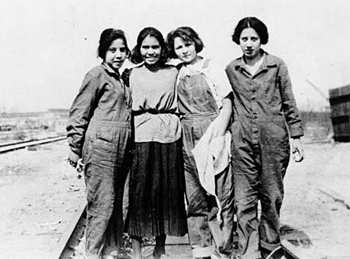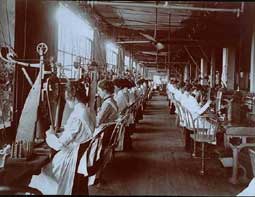 |
||||
|
Women Rising, Then and Now
"In the black of the winter of nineteen-nine, THE LYRICS TO the song "The Uprising of the Twenty-Thousand" remind us of the power of organization and solidarity among women workers. Although as this century opened women lacked the right to vote, worked in sweated industries when they worked outside the home and were generally viewed by the men who controlled the craft unions as "unorganizable," the 1909-10 general strike of women shirtwaistmakers in New York and Philadelphia revealed their enormous capacity to fight in their own names.
The women won a shorter work week, higher wages and "prompt consideration" of their grievances even as they lost their main demand: union recognition. The strike galvanized a sector of the working class, exposing the complicity of the police and courts with union-busting employers. Two years later, on March 25, 1911 a fire broke out at New York's Triangle Shirtwaist Factory. Although the factory was "fireproof," 146 women, children and men were killed-trapped by locked doors that led to the stairway. This event also played a key role in publicizing the need for health and safety regulations, and a union to enforce the law. Another example is the story of the "Radium Girls," dial painters poisoned by the radium paint on the brushes they rolled in their mouths, summarized in Sherry Baron's review article in this issue. As the twentieth century draws to a close it is obvious that one of its most lasting historical transformations has been the continued entry of women into the paid work force and their continued right to fair and equal treatment in the workplace. In 1900 there were 5.3 million women workers-mostly single women-representing 18% of the work force. Even given the post-World War II propaganda against women working, by 1950 women were 30% of the working population. By 1997 more than 63 million working women made up 46% of the work force. It is estimated that by the year 2000 as many women as men will be working outside the home. Regardless of their marital status, the majority of women-even those with young children-work for pay. Yet today U.S. women who work full time earn seventy-five cents for every dollar earned by men.
While the majority of men earn more than $25,000 a year, 70% of all working women earn less. It's true that the last minimum wage hike was beneficial to women, who were 58% of those whose wages were increased. Yet it's a basic economic fact that fully one-third of all working women hold low-wage jobs (one-fifth of all men do). And 70% of the part-time work force is female. So it's not surprising to find that women are 47% of the growing number of workers forced to hold multiple jobs as a way of cobbling together enough money to get by. As a result of women's concentration at the lowest end of the wage scale, 30% of all working women lack health coverage and retirement benefits. Only 8% have jobs that offer any kind of help with childcare. But for the 23% of working women who work part-time, the majority do not even have paid sick leave! Not only women workers, but also their families, suffer when wages are low and benefits non-existent: 64% of all working women provide half or more of the family income, and women are the sole support of more than 18% of all families (12.8 million families). Yet U.S. women's pay is lower than men's both on the average and within the same occupational and educational categories; women (and their dependents) are more likely to be poor, more likely than men to work irregularly and insecurely; women work more hours in the paid work force than a generation ago, without much help within the home; and in times of cutbacks women are pressed into more intensive household labor in order to save. While it is true that worldwide more women than men live in poverty, the U.S. gender pay gap is greater than exists in many other industrial countries, including Australia, Austria, Germany, Italy, Norway and Sweden. The gap is even more devastating because neither the federal or state governments address the problem through social programs that would benefit working women and their children-especially now after welfare reform has gutted most programs that did exist.
What Do Women Want?Abolitionist and suffragist Sarah Grimke, in response to an antifeminist Pastoral Letter of 1837, said: "I ask no favors for my sex . . . All I ask our brethren is, that they will take their feet from off our necks and permit us to stand upright on the ground which God designed us to occupy." Today's generation of women demand no less: a humane <|>and <|>safe work <|>environment, the right to economic security and policies that allow workers a chance to gain greater control over their time. When asked in a survey about what she needed in order to make changes in her job one office worker replied, "I've got plenty of information; it's power I don't have." Getting that power on the job seems to be something that women see as requiring collective action. Despite a corporate culture that emphasizes competition and "self-reliance," a large majority of women tell researchers that the best way to solve problems is for women to join together and work as a group. As a direct consequence, women are highly motivated to seek unionization. Cornell University director of labor research Kate Bronfenbrenner pointed to the rise in union membership of women to 39.4% in 1998, almost double what it was in 1960, and this despite the continued drop in the percentage of organized labor (which now stands at 14.1%).
According to Bronfenbrenner's findings, 48% of all employees organized through union elections last year were in sectors where women and people of color predominate. In fact, the success of union-organizing campaigns averaged as high as 60%, being most successful when the organizing campaign was in the hands of workers themselves. These numbers are especially striking when we consider that existing labor laws actually discriminate against women workers who tend to work in industries not protected by the provisions of the National Labor Relations Act. Dorothy Sue Cobble, editor of the book Women and Unions, estimates that 39% of women are explicitly exempted from the NLRA; and in practice, the NLRB process effectively bars many more women who do temporary or part-time work. According to A Report on the National Survey from the Working Women's Department of the AFL-CIO, 1998, women are demand change from employers and the government, and seeking help from labor unions, working women's organization, community and civic groups. It is clear that the source of power for social change resides in the capacity for self-organization and for building a broad alliance around specific issues. In today's global economy, much of the "sweated" work immigrant and Black women did at the beginning of the twentieth century has been shipped across the border, requiring U.S. women to build even broader alliances to fight for better working conditions, living wages and a place in society for children. U.S. women are joining women in Indonesia, Mexico, Guatemala and Thailand, among others, to oppose the use of child labor and to demand sustainable wages, in all countries. Perhaps this struggle seems more daunting than the campaigns of the shirtwaist makers, in this era of heightened capital mobility and continued complicity of the police and courts against workers fighting for their rights. But as the "twenty thousand women" of 1909 learned, by rising together through self-organization, women can be mighty.
|
|
|||
|
|
||||
|
|
||||
 |
|
 |
||



